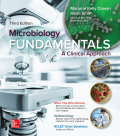
Microbial resistance to drugs is acquired through
- a. conjugation.
- b. transformation.
- c. transduction.
- d. all of these.
Introduction:
Many antibiotics are natural products of fungi and bacteria; therefore, microbes have developed a survival strategy involving resistance to these antibiotics. There are some ways in which microbes acquire antimicrobial resistance, whether antibiotics are present or not.
Answer to Problem 1Q
Correct answer:
Microbial resistance to drugs is acquired through conjugation, transduction, and transformation. Therefore, option (d) is correct.
Option (d) is given as “all of these”
Explanation of Solution
Justify reasons for the correct statement:
One of the main ways in which microbes can acquire antimicrobial resistance is by acquisition of entire new genes or sets of genes via horizontal transfer from another species. This mode begins with plasmids, which are transferred via conjugation, transduction, or transformation. Genes in chromosomes, along with plasmids that contain codes for resistance to drugs can also be replicated to be inherited by successive progenies. This mode leads to emergence of a drug resistance species.
Justify reasons for the incorrect statements:
Option (a) is given as “conjugation”.
Microbial resistance to drugs is acquired through conjugation, transduction, and transformation. Hence, it is a wrong answer.
Option (b) is given as “transformation”.
Only transformation is not sufficient for microbes to acquire resistance to drugs; process of transduction and conjugation are also required. Hence, it is a wrong answer.
Option (c) is given as “transduction”.
Just transduction does not sufficient to microbial resistance to drugs; process of transformation and conjugation are also required. Hence, it is a wrong answer.
Hence, options (a), (b), and (c) are incorrect.
Microbial plasmids are transferred via conjugation, transduction, or transformation to other microbes for the acquisition of resistance to drugs. Genes in plasmids that contain codes for resistance to drugs can also be replicated to be inherited by successive progenies.
Want to see more full solutions like this?
Chapter 10 Solutions
Microbiology Fundamentals: A Clinical Approach
- Explain in a small summary how: What genetic information can be obtained from a Punnet square? What genetic information cannot be determined from a Punnet square? Why might a Punnet Square be beneficial to understanding genetics/inheritance?arrow_forwardIn a small summary write down:arrow_forwardNot part of a graded assignment, from a past midtermarrow_forward
- Noggin mutation: The mouse, one of the phenotypic consequences of Noggin mutationis mispatterning of the spinal cord, in the posterior region of the mouse embryo, suchthat in the hindlimb region the more ventral fates are lost, and the dorsal Pax3 domain isexpanded. (this experiment is not in the lectures).a. Hypothesis for why: What would be your hypothesis for why the ventral fatesare lost and dorsal fates expanded? Include in your answer the words notochord,BMP, SHH and either (or both of) surface ectoderm or lateral plate mesodermarrow_forwardNot part of a graded assignment, from a past midtermarrow_forwardNot part of a graded assignment, from a past midtermarrow_forward
 Medical Terminology for Health Professions, Spira...Health & NutritionISBN:9781305634350Author:Ann Ehrlich, Carol L. Schroeder, Laura Ehrlich, Katrina A. SchroederPublisher:Cengage Learning
Medical Terminology for Health Professions, Spira...Health & NutritionISBN:9781305634350Author:Ann Ehrlich, Carol L. Schroeder, Laura Ehrlich, Katrina A. SchroederPublisher:Cengage Learning
 Comprehensive Medical Assisting: Administrative a...NursingISBN:9781305964792Author:Wilburta Q. Lindh, Carol D. Tamparo, Barbara M. Dahl, Julie Morris, Cindy CorreaPublisher:Cengage Learning
Comprehensive Medical Assisting: Administrative a...NursingISBN:9781305964792Author:Wilburta Q. Lindh, Carol D. Tamparo, Barbara M. Dahl, Julie Morris, Cindy CorreaPublisher:Cengage Learning Human Biology (MindTap Course List)BiologyISBN:9781305112100Author:Cecie Starr, Beverly McMillanPublisher:Cengage Learning
Human Biology (MindTap Course List)BiologyISBN:9781305112100Author:Cecie Starr, Beverly McMillanPublisher:Cengage Learning





